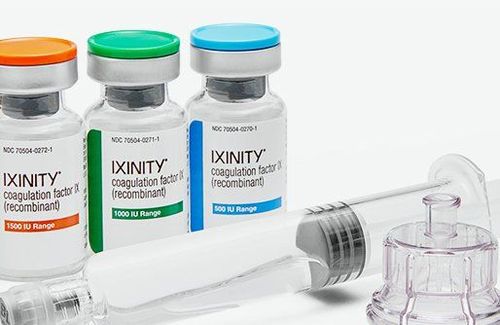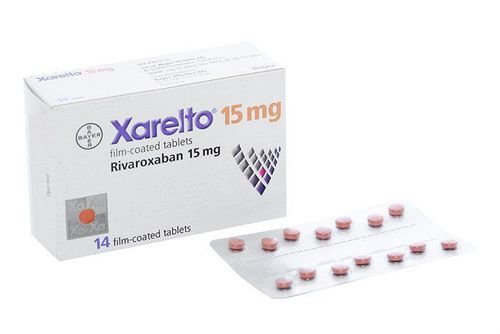This is an automatically translated article.
Blood clots are the result of a series of events that occur during hemostasis including vasoconstriction, platelet aggregation, and coagulation. This can be the cause of angina attacks, heart attacks, strokes or venous thromboembolisms and have severe consequences. The use of anticoagulants plays an important role in the prevention and treatment of diseases caused by thrombosis.1. What is the new oral anticoagulant?
Oral anticoagulants, including vitamin K antagonists and newer oral anticoagulants, are used to treat patients with risk factors for thromboembolism due to atrial fibrillation, venous thromboembolism, pulmonary embolism, and prosthetic valves. . Use of these drugs has the potential to increase the patient's risk of bleeding and major bleeding that can be life-threatening.While vitamin K antagonists have been used for 50 years, new oral anticoagulants (NOACs) have only been introduced recently and drug-induced bleeding complications are of great concern because there is currently no antidote (antidote) except dabigatran but not available in Vietnam.

Thuốc kháng đông đường uống bao gồm cả kháng vitamin K và kháng đông đường uống mới đều dùng để điều trị bệnh nhân có yếu tố nguy cơ huyết khối thuyên tắc
2. Risk of bleeding in patients on new oral anticoagulant therapy:
The new oral anticoagulant (NOAC) is a specific enzyme inhibitor of the coagulation cascade with the potential to be more effective than vitamin K inhibitors in the prevention of stroke and systemic embolism, especially in reducing bleeding rates. internal blood. The bleeding risk with NOACs is also lower or similar when compared with other agents, with the exception of a few exceptions, such as a higher risk of gastrointestinal bleeding in patients over 65 years of age.According to studies in patients with atrial fibrillation or venous thrombosis, NOACs have been shown to reduce the risk of fatal major bleeding and intracranial bleeding. Factors that may increase the risk of bleeding include:
Older age (especially over 80 years) Reduced kidney function Low weight Concurrent use of NSAIDs, antiplatelets, systemic corticosteroids Recent major surgery
3. How is the patient assessed for bleeding on new oral anticoagulants?
For the appropriate treatment of bleeding complications associated with the use of NOACs, it is important to assess the patient to help classify the bleeding severity, anticoagulation status, or underlying medical condition for which anticoagulation is indicated. The necessary initial evaluation of the patient includes:Assess the severity of bleeding and the degree of hemostasis, taking a thorough history and taking medications A major bleeding is when: Bleeding in vital organs (brain-dural, pericardial, orbital, large joints,...), Hg reduction > 2g, transfusion of more than 2 units of blood or major surgery, vasopressor therapy Assess risk of embolism Severe obstruction on discontinuation of NOACs May require an anticoagulation assay to check for NOACs activity.
4. Management of bleeding complications when taking new oral anticoagulants

Nguyên tắc chung là ngưng thuốc kháng đông, tận dụng mọi biện pháp cầm máu có thể
In addition, there will be Individual treatment regimens for each degree of bleeding are as follows:
Mild bleeding: Need to delay or stop next dose, review concurrent medications Moderate-severe bleeding: Patient needs measures support such as mechanical compression, surgical hemostasis, fluid resuscitation, HCL transfusion if necessary, fresh plasma transfusion (such as plasma volume replacement), platelet transfusion if platelets are below 60K/microL. In addition, maintenance diuresis or dialysis may be considered for Dabigatran Life-threatening bleeding: Consider administration of prothrombin complex concentrate (PCC) 25 U/kg repeated 1-2 times or Activated PCC 50 IE/kg (maximum 200 IE/kg/day or activated factor VII. For post-bleeding therapy it is necessary to re-evaluate the patient's condition and weigh the risks to decide whether to resume treatment. NOACs or not, the general rule is as follows:
Use the same or lower dose or switch to another drug of the same class with less side effects Switch to a vitamin K antagonist Reduce or antiplatelet Use a protective drug such as PPI to prevent bleeding Non-drug alternative to Vinmec International General Hospital with a system of modern facilities, medical equipment and a team of experts and doctors with many years of experience in medical examination and treatment, patients You can completely rest assured that you will be examined and treated at the Hospital.
Please dial HOTLINE for more information or register for an appointment HERE. Download MyVinmec app to make appointments faster and to manage your bookings easily.
MORE8 things to keep in mind with patients on anticoagulants 8 things to keep in mind with patients on anticoagulants Side effects of anticoagulants













